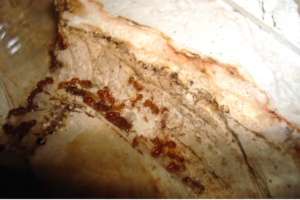Get to know Mikey Bustos, radio DJ in the Philippines; master ant keeper everywhere else.
Text by Patricia Calzo Vega
Most of us know Mikey Bustos as the Pinoy pride-serving Fil-Canadian YouTube sensation and co-host of Magic 89.9’s Good Times in the Morning show, but for ant enthusiasts around the world, Bustos is better known as the founder of Ants Canada (http://antscanada.com), an organization that promotes ant keeping as a hobby, the scientific study of ants, its ecology, and habitat conservation.
Unsurprisingly, Ants Canada has quite the online following, with thousands of subscribers accessing its forums, YouTube channel, and Facebook page, where Bustos shares his ant keeping techniques and fields questions from viewers, with as much gusto as his popular parodies and sketches.
Why ants? “Ants are like humans in so many ways and deal with the same problems humans do. They are such complex and interesting animals,” he enthuses. Like humans, ants are widespread across the world—native species exist in all continents, except Antarctica. Ant colonies are characterized as superorganisms, arguably among the most evolved of animal collectives, exhibiting highly specialized division of labor that enables ants to defend themselves, modify habitats, share the rearing of their young, and solve complex problems. Bustos’s interest in antkeeping dates from childhood.

“I have always loved insects as a kid and luckily my parents allowed me to keep ants which eventually led me to enter the sciences in school and found [Ants Canada] as an adult.” He extols the virtues of antkeeping in a YouTube video entitled “Why An Ant Farm? A Message For Parents”: “One of the advantages of keeping ants is teaching your child a sense of responsibility and routine required to care for animals. It also gives your child a good introduction to biology and systems, which can give them a broader understanding and admiration for nature.”
Colony basics To start a captive colony, one must possess a fertilized queen ant. Unlike other pet hobbies—like, say, the care of marine aquariums—where owners are expected to purchase their initial stock, the responsible, sustainable way to raise ants is to capture a wild queen during her nuptial flight (breeding season).
Using local ant species ensures that, in case of accidental release, antkeepers do not introduce invasive ant species and disrupt the delicate balance of their local ecosystem. An advocate of responsible antkeeping, Bustos organized the Global Ant Nursery (GAN) for ant lovers who want to start their own colonies but have difficulty catching queens on their own.
The GAN is a network of antkeepers that sell native queens or starter captive colonies to enthusiasts who live within 250 km of the GAN farmer. There are two listed GAN farmers in the Philippines, based in Manila and Cebu; both offer Solenopsis geminate (tropical red fire ant) for sale to hobbyists. Captive queens can be kept in a test tube setup (a regular test tube partially filled with water and plugged with cotton balls), which simulates the underground chambers in which the queen lays its eggs.
Once a sufficient number of worker ants are born—Bustos suggests a ratio of around twenty worker ants to one queen—you can prepare the new colony to move to a standard formicarium and outworld setup. The colony must be allowed to move at its own pace, but an antkeeper can make things a little easier by placing the test tube into the formicarium directly and lay the test tube opening close to the nest area.

The formicarium serves as the colony’s nest, and must have proper hydration, ventilation and temperature control. The outworld, on the other hand, serves as its foraging area. “Ants are clean and organized. They set up graveyard and waste disposal sites,” he observed. Bustos has filmed over 35 tutorial videos for Ants Canada and has self-published an e-book, “The Ultimate Antkeeping Handbook”, where he provides a comprehensive overview of the ins and outs of antkeeping, such as notes on proper nutrition (pro-tip: ants require sugar, protein, and water to live) down to detailed information on various ant species and their nuptial flights.
Patience is a virtue necessary for ant-keeping: it can take months for a starter colony to grow, and the set-up must be assembled meticulously to avoid accidents. But, according to Bustos, it definitely has its own rewards. “A queen ant can survive up to 30 years depending on the species, and as long as she is alive to lay eggs, the colony will continue.”
For more information on local ant species, antkeeping supplies, and advice, interested individuals can check out the Philippine Ants & Myrmecology Society on Facebook.
This appeared as “Meet the Ant Man” in Animal Scene’s September 2015 issue.






